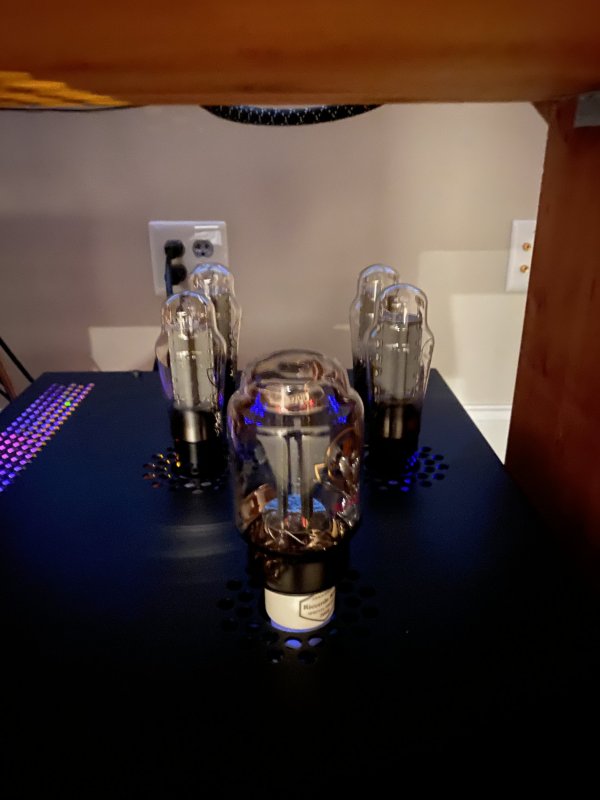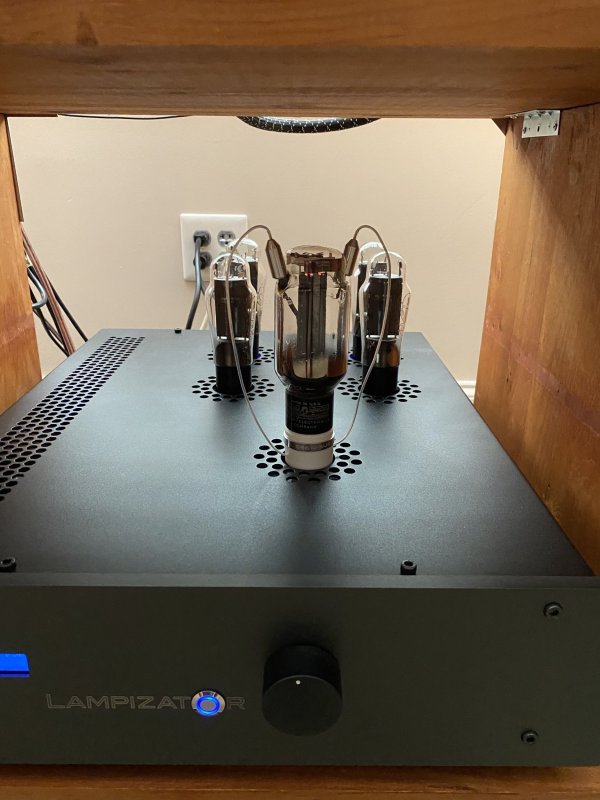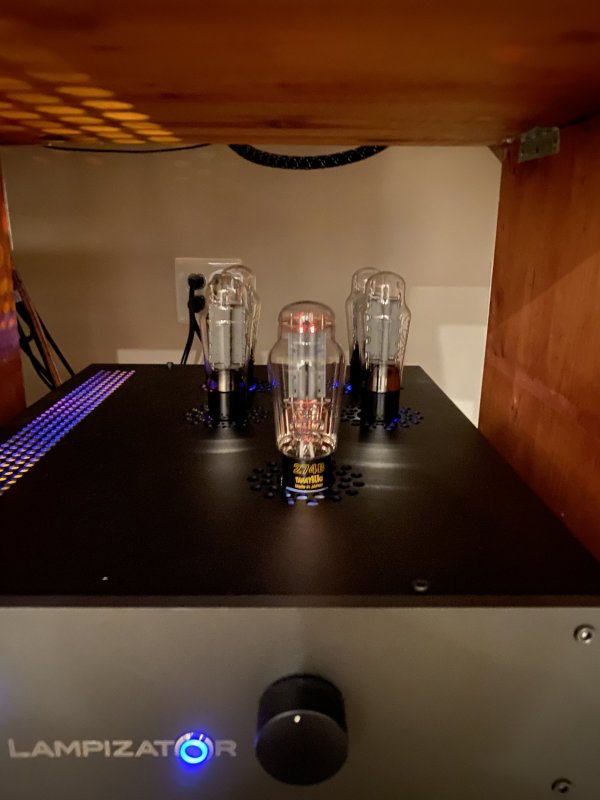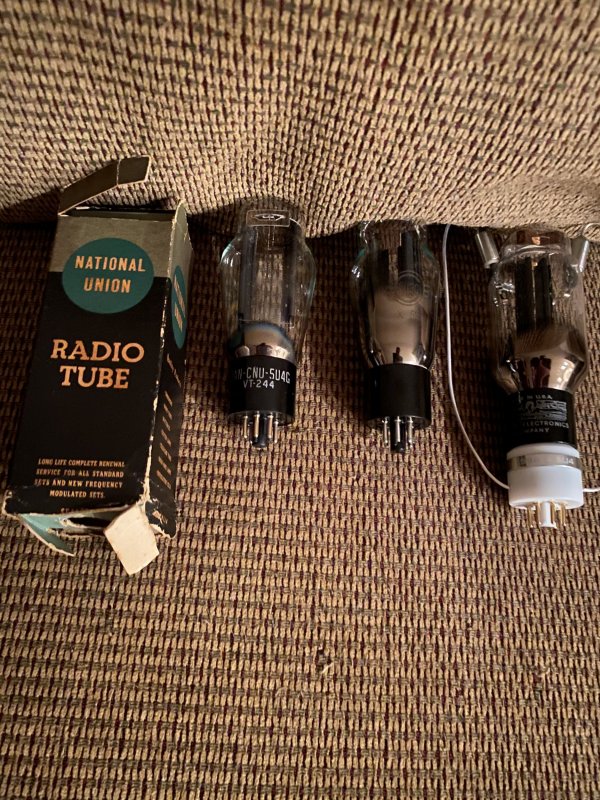Rectifiers for the Horizon
Long before my Horizon arrived, I started acquiring some tubes with the hope that some tube rolling would allow me to optimize the sound of the Horizon in my particular system. After all, that’s the purpose of tube rolling. There are many ways one can approach this, but optimizing 3 different tube (recti’s, pentodes and triodes) can get out of hand and be difficult to sort out without some sort of plan. Of course, there’s the always popular “let’s stick this thing in and see what happens approach” but in general, that’s not my preferred method of choice. I thought it would be reasonable to try and tame this project by taking a more systematic approach. I therefore used my GG2 to evaluate rectifiers in anticipation of the Horizon’s arrival.
One thing that should be said immediately, and which has been said before, is that there are really no bad tube choices for the Horizon. It is a remarkable and beautiful instrument whose performance can be optimized for individual taste. Lukasz was correct when he said that the stock tubes he currently supplies offer some genuine magic. But just like ice cream, there is vanilla, chocolate and strawberry so why not try a few flavors to see if one’s system just might benefit accordingly?
A couple of useful ground rules learned from experience that made this exercise both easier and more difficult at the same time, are:
- There is no such thing as a perfect tube. I don’t even know what that means. All tubes have a characteristic sound. So, tube rolling is really an exercise in flavorings more than anything else. What works for you might not work best for me and vice versa.
- What works well in one application (such as a recti) may very well depend on what that tube(s) it is paired with. In the case of the GG2 it is only used with DHT outputs. In the case of the Horizon, it is used with both the pentodes and triodes.
Still, I thought if I could get a sense of the qualities from various recti’s in the GG2, that would stand me in good sted to try and assess the triode and pentode tubes while holding at least one variable more or less constant. So, I spend 6 months evaluating recti’s on the GG2. I knew those observations may or may not be useful in the Horizon since the recti would no longer be used with a DHT, but rather, with triodes and pentodes that are used in Lukasz’ unique “virtual” octal implementation.
It became obvious after trying quite a variety of recti’s, that the Takatsuki 274b was the most satisfactory recti in my GG2 so that’s what I installed immediately in the Horizon. But in July, for reasons unknown, my Tak failed! I sent it back to Alex who said it was the first failure he has seen, but he replaced it immediately under warranty. This was actually a blessing in disguise as it allowed me to return to several recti’s that I could now evaluate in the Horizon, which I had only tried in the GG2 previously. Even better, when the new Tak arrived, I was able to re-evaluate it in the Horizon once again, in comparison to recti’s also evaluated using the same triodes and pentodes in the Horizon. With this as background, here are some impressions of some fairly common and readily available rectifiers for the Horizon.
I’ll add that all recti’s were evaluated after a minimum of 72 hours. This is important. The tubes take time to show their best and changing tubes with less than 3 days, preferably 5, will often be deceptive. There were tubes that after 24 hours I wanted to remove immediately, but forced myself to listen to for 3 days, after which my opinion may have changed significantly from “dog” to “keeper”!
We might as well start at the top. The Tak 274b is my current recti of choice in the Horizon. Simply put it is big, bad and bold. But let’s be clear. It has a very distinct sound. It is a bit dark or “yin” if you want to use HP nomenclature. In Valin terminology it is definitely a “bottom up” sound. But it does something that no other recti does, which is knit together the bass and midbass through the upper bass so coherently and so seamlessly that symphonic music in particular has a foundation that’s damn hard not to love. Male voices can be riveting. Lower brass is extraordinary and this is an area in which it is unsurpassed in my system. It’s also a tube that might allow some users to be more satisfied if they do not want or cannot use a subwoofer as the bass performance in terms of extension and definition is outstanding. However, it is not a perfect tube. For example, while the piano left hand is superb, it does tend to make the piano middle register a bit dark so that a Steinway might actually sound a bit like a Bosendorfer. A Dutch GZ34, in my system, actually performs a more accurate rendering of a Steinway on almost every recording I have played. The Tak is also very kind to the top end and might be a preferred recti on systems with tweeters that are bit harsh when overloaded, such as the infamous and popular Focal beryllium tweeter. (This might actually be considered a
good thing!) But these are minor nits to pick in what is otherwise an exemplary rectifier. It may not be perfect, but since nothing is, I’m sticking with it as my preferred Horizon recti. Of course, another downside is the price but nobody who buys a Horizon is going to be taken seriously if they start complaining about the price ($1200) especially since there’s not another recti that can do what the Tak does.
The next tier incudes 3 recti’s that I also like a great deal. The first is the Dutch GZ34. GZ34’s are made both by Mullard (and often re-labeled) or made by others, many of which are Dutch. The key here is that even though they are labeled Philips, Amperex or Dario Miniwatt, it’s important to make sure they are not Mullards made in Blackburn but rather made in Holland (dates codes have an L” or “X”). As impressive as the Dutch GZ34’s are, the Mullards are not my cup of tea- they’re less dynamic and lifeless compared to the wonderful musicality of the Dutch equivalents. ($200-300). Don’t be fooled by their size. They are indeed the real deal.
The next recti in this group is the RCA VT-244 JAN CRC-5U4G (with hanging filaments). This is an excellent recti whose calling card is its prodigious, powerful but excellent bass. In fact, it’s really tube that enjoys its reputation based on its use in guitar amplifiers such as the big Marshalls. Once you hear it, you’ll understand why. It may not offer the last word in midrange refinement or top end beauty, but in some systems, it might be a superb performer. (about $225)
Finally, there is the sleeper of the bunch, the US Amperex 5U4G. What a gorgeous tube. It offers a beautiful midrange and top end but it is not going to make bass freaks cry with joy. It’s very good there, but not exceptional. It is also far and away, the bargain of the lot. At about $40 it is a steal.
If I were to compare the second-tier tubes, I would say the RCA is the bass champ, the Amperex is the most beautiful midrange and top end performer, and the Dutch GZ34 straddles both and may be my favorite if I had to satisfy all my concerns from bottom to top. All excellent in their own way.
There are also several other recti’s I’ve tried in either the GG2 or Horizon that I just don’t have enough extended experience with to comment on such as the Emission Labs 274b and a Telefunken 5U4G. Long ago I listened to the stock KR5U4G but long ago abandoned it for the RK version which I liked, but not as much as the ones mentioned. Like everyone else, I’d like to hear a bonifide Western Electric 274B but can’t bring myself to pull that trigger since finding replacements for any of them I could buy would be near impossible and costly. When WE remakes them, let me know. In the meanwhile, if I had to take one to a desert island, the Tak 274b would surely be the one I’d pack.
I hope you can see that the stage is now set for evaluating pentodes and triodes but again they key is the final sound pairings, and not necessarily is the tube that might be selected solely for its own specific qualities. For example, a recti with big bass might pair well with a triode that is excellent but is a bit light in the bass. Conversely, a recti that is bass light might be the perfect mate for a big bass triode. These are all system dependent pairings but unfortunately, it will take time to sort this out. Next up, hopefully a few glimpses into the triode and pentode possibilities. This is the fun part of the hobby for me and no matter what I tubes I play, the Horizon makes such evaluations a joy to listen to and assess.













